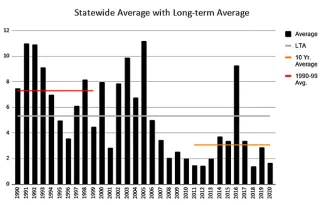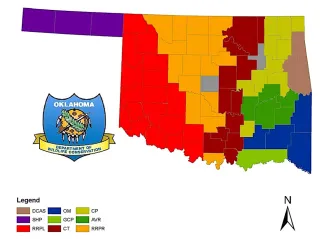
By Tell Judkins, Upland Game Biologist
The 2020 August roadside quail observation survey shows the statewide quail index down from 2019, dropping from 2.88 to 1.68. This is 68.48 percent below the 31-year average of 5.33, and 45.28 percent below the 10-year average of 3.07. However, when evaluated by ecoregion, Oklahoma’s quail index went up over last year in five of the state’s nine ecoregions.
The Oklahoma Department of Wildlife Conservation has conducted annual roadside surveys in August and October since 1990 to provide an index of annual population fluctuations for quail. The number of quail observed are reported to provide an index of quail abundance and indicates reproductive success. Currently, Wildlife Department employees survey 83 routes in 75 of Oklahoma’s 77 counties. Oklahoma and Tulsa counties, both having almost exclusively urban landscapes, are excluded from the survey.
The state is divided into either geographic regions or ecoregions to compare the indexes year to year. Looking at both divisions provides a more precise view of on-the-ground conditions in each county. One or two ecoregions being down can have an overall negative impact to the entire region’s index. For example, the Northwestern Region shows to be down in observations. But only two of the three ecoregions within that geographic region are down, and in the third ecoregion, observations are actually up from last year. Comparing results from both geographic regions and ecoregions provides a better look at the county that someone intends to hunt.

There are several theories as to what has caused the year-over-year decline, primarily habitat loss and weather. Peak production appears to have occurred in mid-June, which is early in the nesting season. This early hatch might have influenced low August survey numbers as older juvenile birds may be less likely to stay in brood groups while traveling.
The North Central and Southeastern regions of the state improved from 2019’s survey. All regions of the state are below their historic 31-year averages except for the North Central Region, which is 2.18 percent above.
Rainfall, or lack thereof, has been an issue for much of 2020. Drought conditions in the west have negatively affected many wildlife species.
During the past 180 days, some parts of Oklahoma have seen more rainfall than normal, and some parts have seen much less than normal. Dense vegetation along roadsides in some areas of the state could contribute to fewer observations. Given the current drought and rainfall differences statewide, looking at surveys on a "per ecoregion" basis provides another way of assessing bird numbers.
Ecoregions that have experienced drought throughout nesting season, including the Rolling Red Prairie, Southern High Plain and Cross Timbers, are showing lower observation numbers.

No scaled quail were observed during the 2020 August Roadside Surveys, while two scaled quail were observed in August 2019. Only a few routes in Oklahoma offer the opportunity to observe scaled quail. Therefore, this is not a prediction of scaled quail abundance but strictly an observation.
Anecdotally, numerous brood reports from across the state have been received as recently as late August. Over the 31 years of quail roadside surveys, the August surveys have shown that they are not always the most reliable when it comes to forecasting the quail season. Stay tuned for the October roadside surveys, which will provide a better indication of what the upcoming quail season could have in store.
NOTE: Additional graphic information is available at www.wildlifedepartment.com/sites/default/files/2020AugustRoadsideWriteup.pdf.